RENAULT SCENIC 2013 J95 / 3.G Electronic Parking Brake Workshop Manual
Manufacturer: RENAULT, Model Year: 2013, Model line: SCENIC, Model: RENAULT SCENIC 2013 J95 / 3.GPages: 115, PDF Size: 0.64 MB
Page 1 of 115
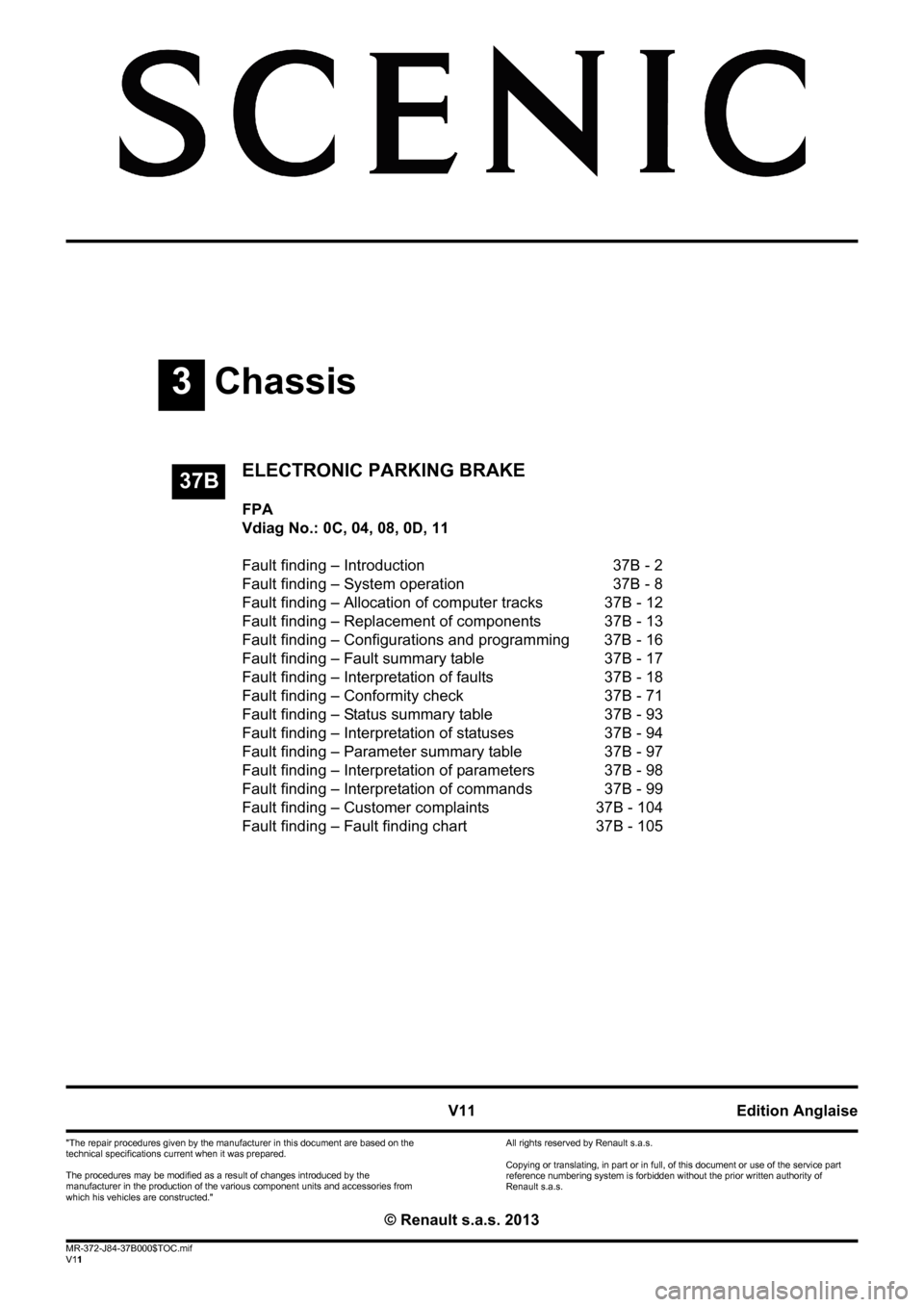
3Chassis
V11 MR-372-J84-37B000$TOC.mif
V11
37B
"The repair procedures given by the manufacturer in this document are based on the
technical specifications current when it was prepared.
The procedures may be modified as a result of changes introduced by the
manufacturer in the production of the various component units and accessories from
which his vehicles are constructed."
V11
All rights reserved by Renault s.a.s.
Edition Anglaise
Copying or translating, in part or in full, of this document or use of the service part
reference numbering system is forbidden without the prior written authority of
Renault s.a.s.
© Renault s.a.s. 2013
ELECTRONIC PARKING BRAKE
FPA
Vdiag No.: 0C, 04, 08, 0D, 11
Fault finding – Introduction 37B - 2
Fault finding – System operation 37B - 8
Fault finding – Allocation of computer tracks 37B - 12
Fault finding – Replacement of components 37B - 13
Fault finding – Configurations and programming 37B - 16
Fault finding – Fault summary table 37B - 17
Fault finding – Interpretation of faults 37B - 18
Fault finding – Conformity check 37B - 71
Fault finding – Status summary table 37B - 93
Fault finding – Interpretation of statuses 37B - 94
Fault finding – Parameter summary table 37B - 97
Fault finding – Interpretation of parameters 37B - 98
Fault finding – Interpretation of commands 37B - 99
Fault finding – Customer complaints 37B - 104
Fault finding – Fault finding chart 37B - 105
Page 2 of 115
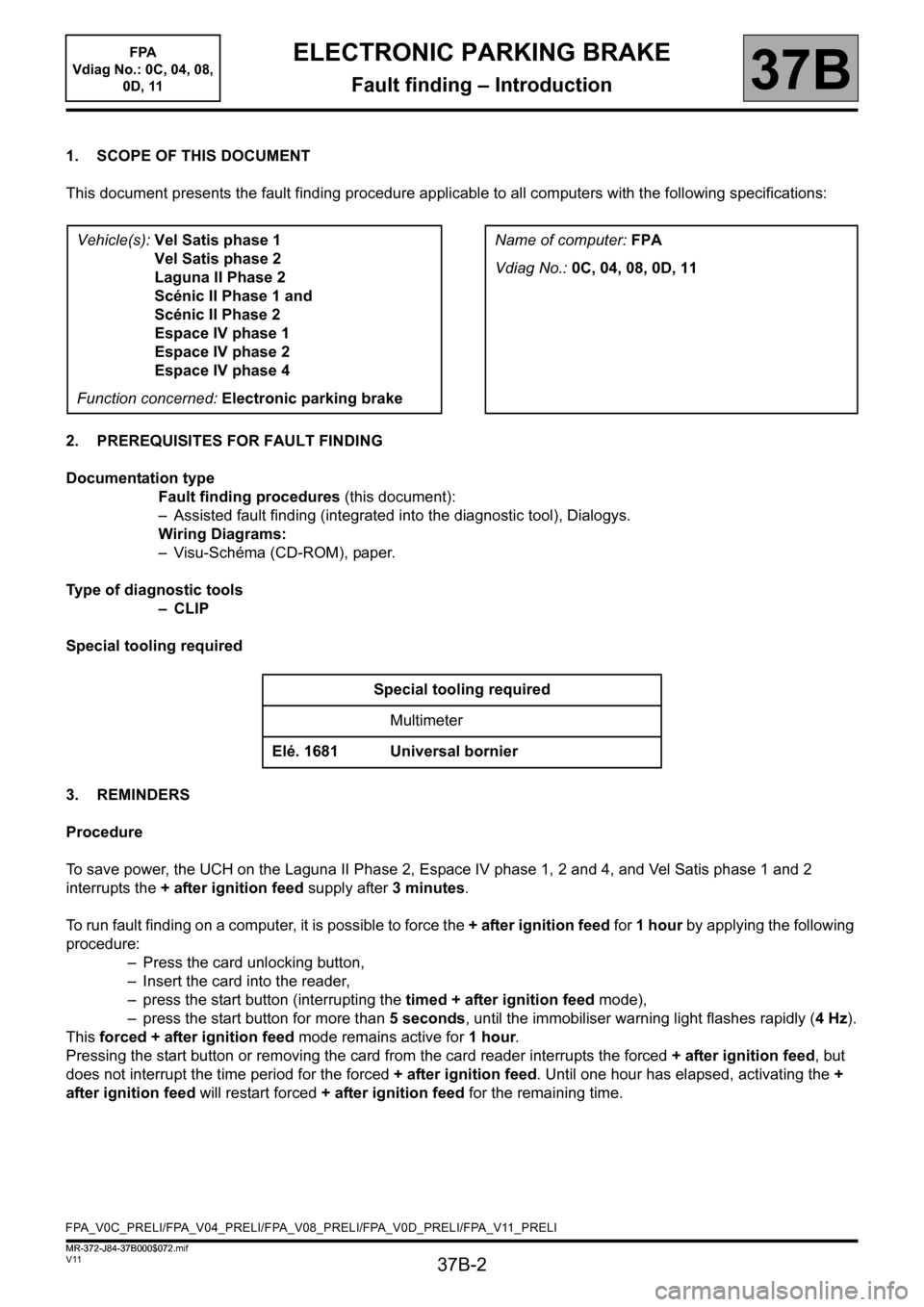
37B-2
MR-372-J84-37B000$072.mif
V11
37B
ELECTRONIC PARKING BRAKE
Fault finding – Introduction
1. SCOPE OF THIS DOCUMENT
This document presents the fault finding procedure applicable to all computers with the following specifications:
2. PREREQUISITES FOR FAULT FINDING
Documentation type
Fault finding procedures (this document):
– Assisted fault finding (integrated into the diagnostic tool), Dialogys.
Wiring Diagrams:
– Visu-Schéma (CD-ROM), paper.
Type of diagnostic tools
–CLIP
Special tooling required
3. REMINDERS
Procedure
To save power, the UCH on the Laguna II Phase 2, Espace IV phase 1, 2 and 4, and Vel Satis phase 1 and 2
interrupts the + after ignition feed supply after 3 minutes.
To run fault finding on a computer, it is possible to force the + after ignition feed for 1 hour by applying the following
procedure:
– Press the card unlocking button,
– Insert the card into the reader,
– press the start button (interrupting the timed + after ignition feed mode),
– press the start button for more than 5 seconds, until the immobiliser warning light flashes rapidly (4 Hz).
This forced + after ignition feed mode remains active for 1 hour.
Pressing the start button or removing the card from the card reader interrupts the forced + after ignition feed, but
does not interrupt the time period for the forced + after ignition feed. Until one hour has elapsed, activating the +
after ignition feed will restart forced + after ignition feed for the remaining time. Vehicle(s): Vel Satis phase 1
Vel Satis phase 2
Laguna II Phase 2
Scénic II Phase 1 and
Scénic II Phase 2
Espace IV phase 1
Espace IV phase 2
Espace IV phase 4
Function concerned: Electronic parking brakeName of computer: FPA
Vdiag No.: 0C, 04, 08, 0D, 11
Special tooling required
Multimeter
Elé. 1681 Universal bornier
FPA_V0C_PRELI/FPA_V04_PRELI/FPA_V08_PRELI/FPA_V0D_PRELI/FPA_V11_PRELI
FPA
Vdiag No.: 0C, 04, 08,
0D, 11
MR-372-J84-37B000$072.mif
Page 3 of 115
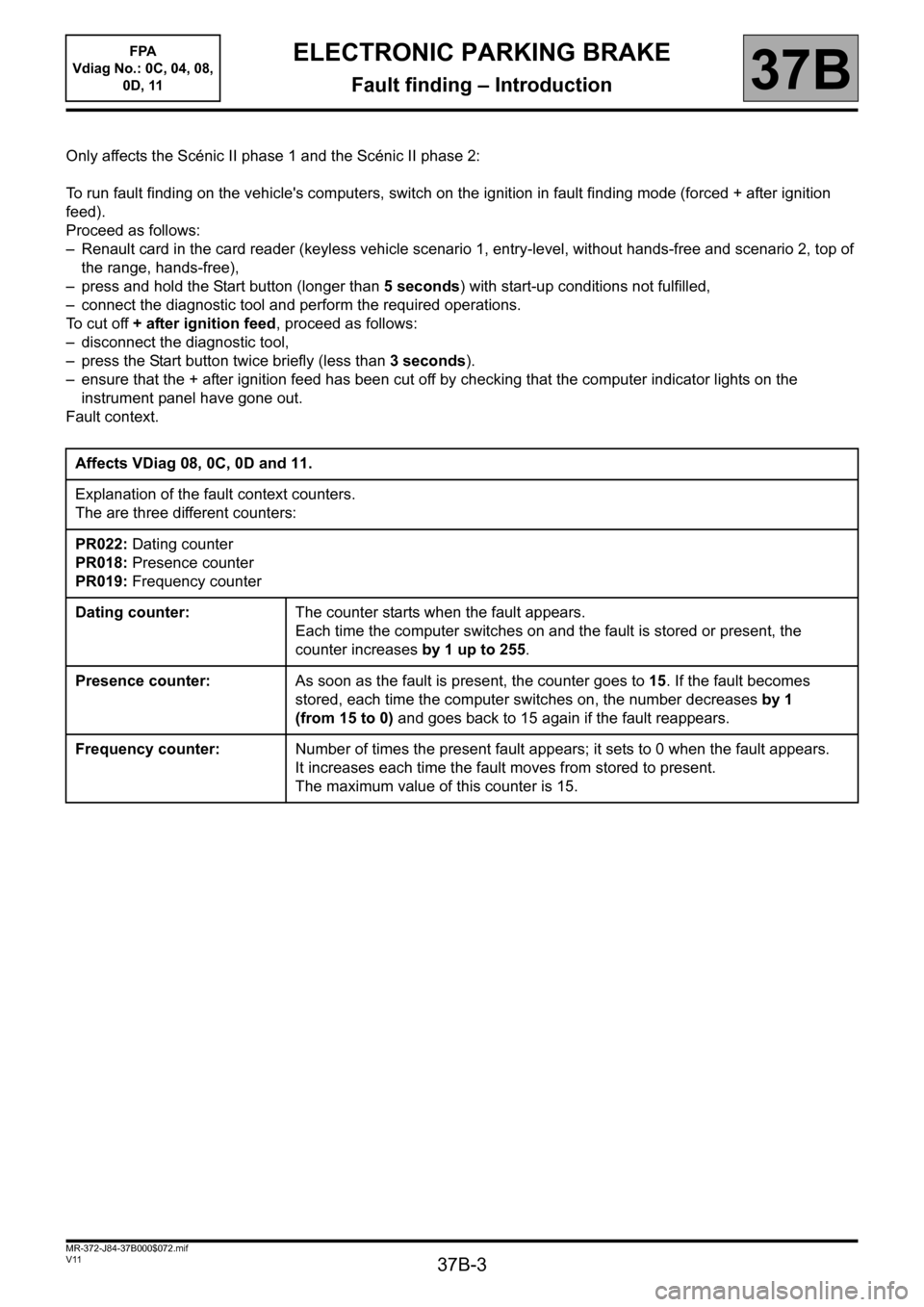
37B-3
MR-372-J84-37B000$072.mif
V11
ELECTRONIC PARKING BRAKE
Fault finding – Introduction
FPA
Vdiag No.: 0C, 04, 08,
0D, 11
37B
Only affects the Scénic II phase 1 and the Scénic II phase 2:
To run fault finding on the vehicle's computers, switch on the ignition in fault finding mode (forced + after ignition
feed).
Proceed as follows:
– Renault card in the card reader (keyless vehicle scenario 1, entry-level, without hands-free and scenario 2, top of
the range, hands-free),
– press and hold the Start button (longer than 5 seconds) with start-up conditions not fulfilled,
– connect the diagnostic tool and perform the required operations.
To cut off + after ignition feed, proceed as follows:
– disconnect the diagnostic tool,
– press the Start button twice briefly (less than 3 seconds).
– ensure that the + after ignition feed has been cut off by checking that the computer indicator lights on the
instrument panel have gone out.
Fault context.
Affects VDiag 08, 0C, 0D and 11.
Explanation of the fault context counters.
The are three different counters:
PR022: Dating counter
PR018: Presence counter
PR019: Frequency counter
Dating counter:The counter starts when the fault appears.
Each time the computer switches on and the fault is stored or present, the
counter increases by 1 up to 255.
Presence counter:As soon as the fault is present, the counter goes to 15. If the fault becomes
stored, each time the computer switches on, the number decreases by 1
(from 15 to 0) and goes back to 15 again if the fault reappears.
Frequency counter:Number of times the present fault appears; it sets to 0 when the fault appears.
It increases each time the fault moves from stored to present.
The maximum value of this counter is 15.
Page 4 of 115
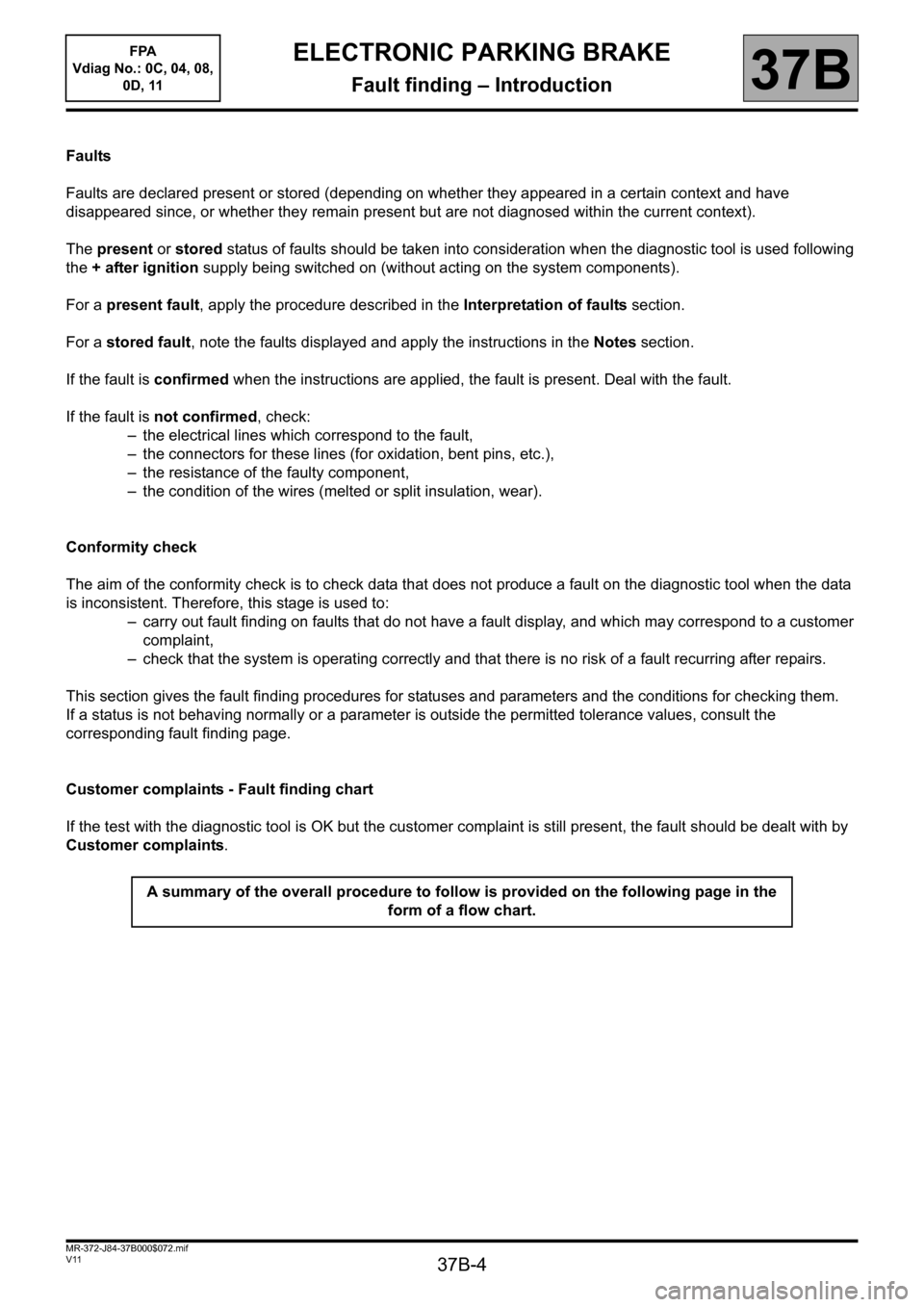
37B-4
MR-372-J84-37B000$072.mif
V11
ELECTRONIC PARKING BRAKE
Fault finding – Introduction
FPA
Vdiag No.: 0C, 04, 08,
0D, 11
37B
Faults
Faults are declared present or stored (depending on whether they appeared in a certain context and have
disappeared since, or whether they remain present but are not diagnosed within the current context).
The present or stored status of faults should be taken into consideration when the diagnostic tool is used following
the + after ignition supply being switched on (without acting on the system components).
For a present fault, apply the procedure described in the Interpretation of faults section.
For a stored fault, note the faults displayed and apply the instructions in the Notes section.
If the fault is confirmed when the instructions are applied, the fault is present. Deal with the fault.
If the fault is not confirmed, check:
– the electrical lines which correspond to the fault,
– the connectors for these lines (for oxidation, bent pins, etc.),
– the resistance of the faulty component,
– the condition of the wires (melted or split insulation, wear).
Conformity check
The aim of the conformity check is to check data that does not produce a fault on the diagnostic tool when the data
is inconsistent. Therefore, this stage is used to:
– carry out fault finding on faults that do not have a fault display, and which may correspond to a customer
complaint,
– check that the system is operating correctly and that there is no risk of a fault recurring after repairs.
This section gives the fault finding procedures for statuses and parameters and the conditions for checking them.
If a status is not behaving normally or a parameter is outside the permitted tolerance values, consult the
corresponding fault finding page.
Customer complaints - Fault finding chart
If the test with the diagnostic tool is OK but the customer complaint is still present, the fault should be dealt with by
Customer complaints.
A summary of the overall procedure to follow is provided on the following page in the
form of a flow chart.
Page 5 of 115
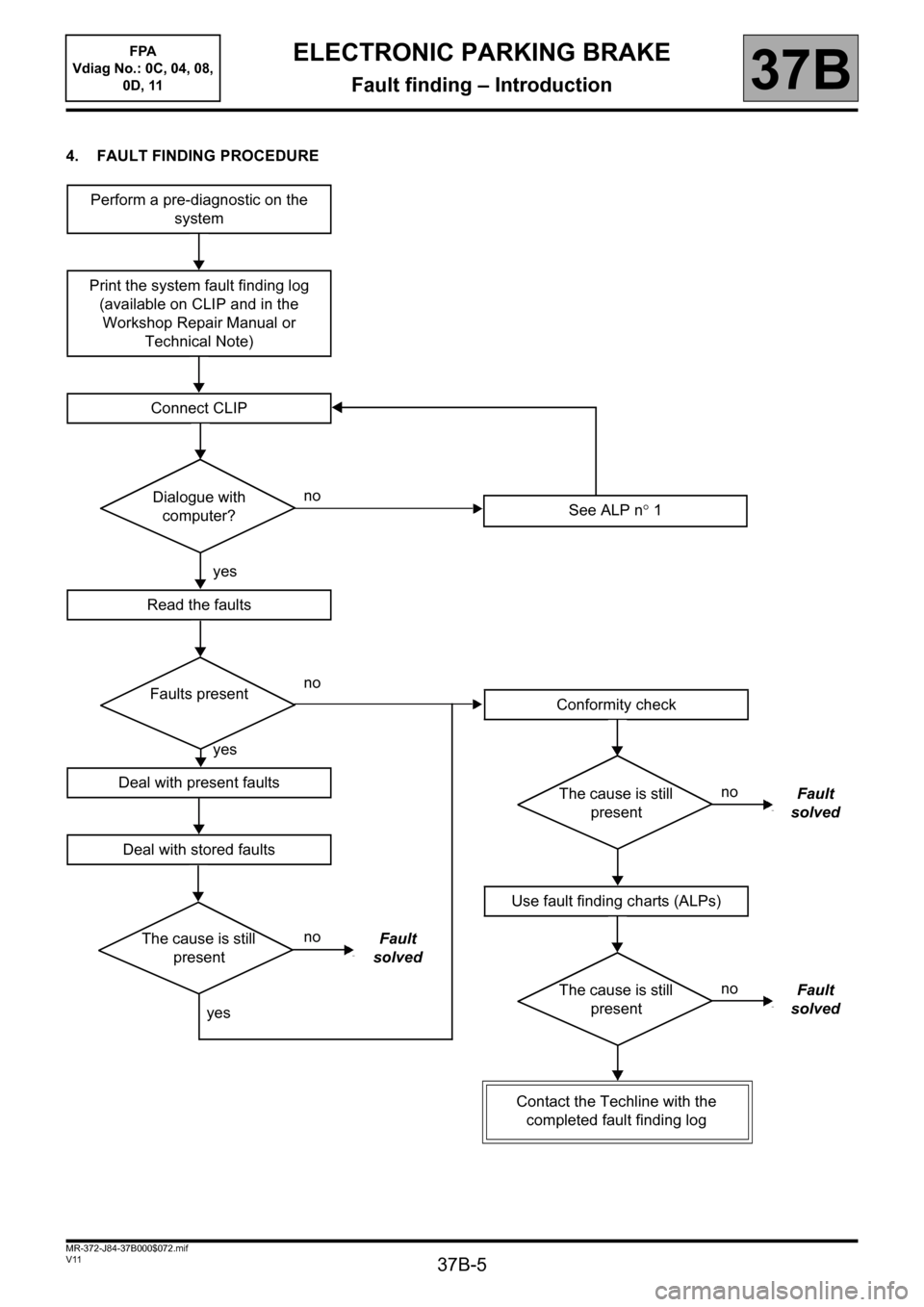
37B-5
MR-372-J84-37B000$072.mif
V11
FPA
Vdiag No.: 0C, 04, 08,
0D, 11ELECTRONIC PARKING BRAKE
Fault finding – Introduction37B
4. FAULT FINDING PROCEDURE
Perform a pre-diagnostic on the
system
Print the system fault finding log
(available on CLIP and in the
Workshop Repair Manual or
Technical Note)
Connect CLIP
no
Dialogue with
computer?
yes
Read the faults
no
Faults present
yes
Deal with present faults
Deal with stored faults
no
The cause is still
presentFault
solved
yes
See ALP n 1
Conformity check
no
The cause is still
presentFault
solved
Use fault finding charts (ALPs)
no
The cause is still
presentFault
solved
Contact the Techline with the
completed fault finding log
Page 6 of 115
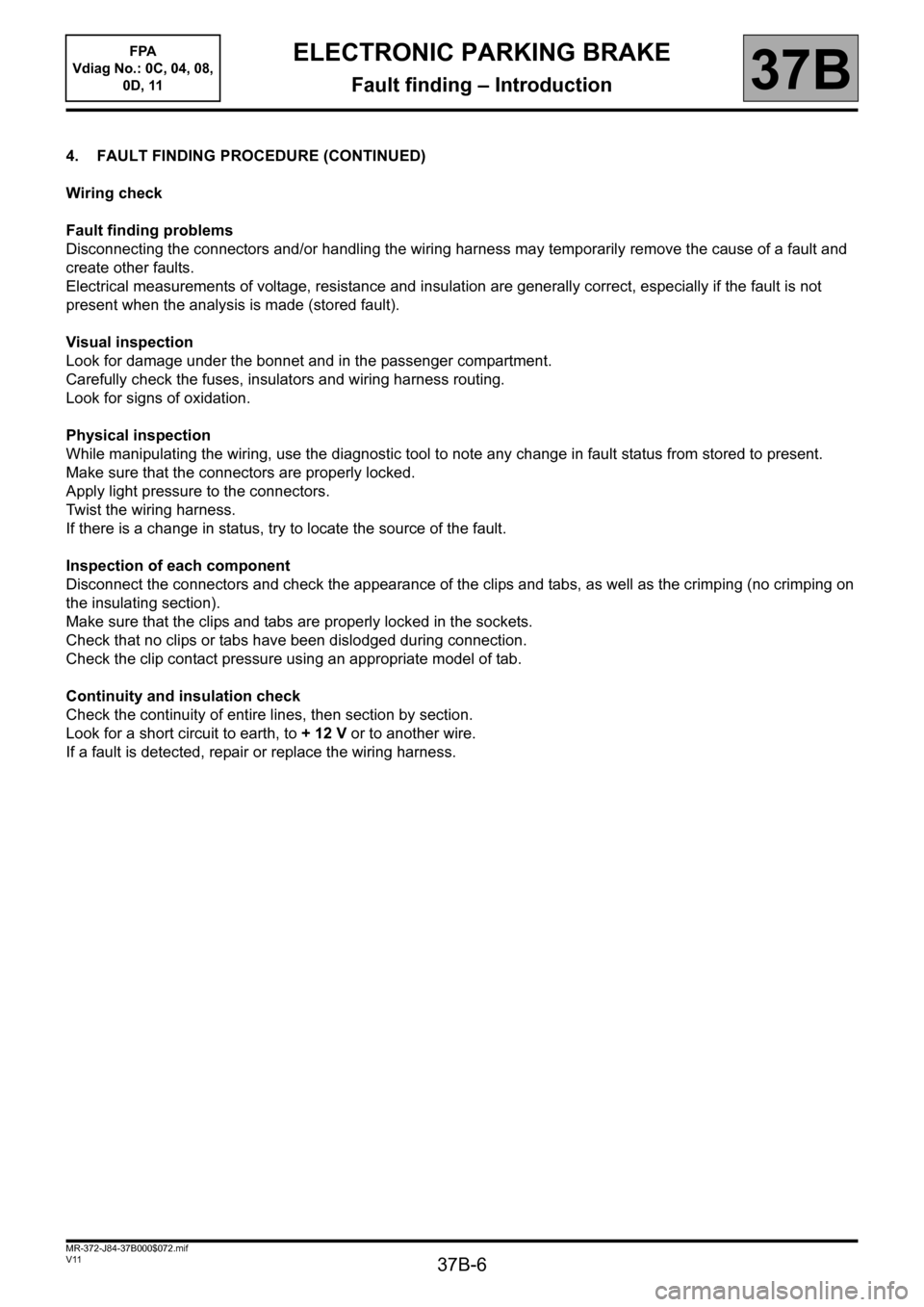
37B-6
MR-372-J84-37B000$072.mif
V11
ELECTRONIC PARKING BRAKE
Fault finding – Introduction
FPA
Vdiag No.: 0C, 04, 08,
0D, 11
37B
4. FAULT FINDING PROCEDURE (CONTINUED)
Wiring check
Fault finding problems
Disconnecting the connectors and/or handling the wiring harness may temporarily remove the cause of a fault and
create other faults.
Electrical measurements of voltage, resistance and insulation are generally correct, especially if the fault is not
present when the analysis is made (stored fault).
Visual inspection
Look for damage under the bonnet and in the passenger compartment.
Carefully check the fuses, insulators and wiring harness routing.
Look for signs of oxidation.
Physical inspection
While manipulating the wiring, use the diagnostic tool to note any change in fault status from stored to present.
Make sure that the connectors are properly locked.
Apply light pressure to the connectors.
Twist the wiring harness.
If there is a change in status, try to locate the source of the fault.
Inspection of each component
Disconnect the connectors and check the appearance of the clips and tabs, as well as the crimping (no crimping on
the insulating section).
Make sure that the clips and tabs are properly locked in the sockets.
Check that no clips or tabs have been dislodged during connection.
Check the clip contact pressure using an appropriate model of tab.
Continuity and insulation check
Check the continuity of entire lines, then section by section.
Look for a short circuit to earth, to + 12 V or to another wire.
If a fault is detected, repair or replace the wiring harness.
Page 7 of 115
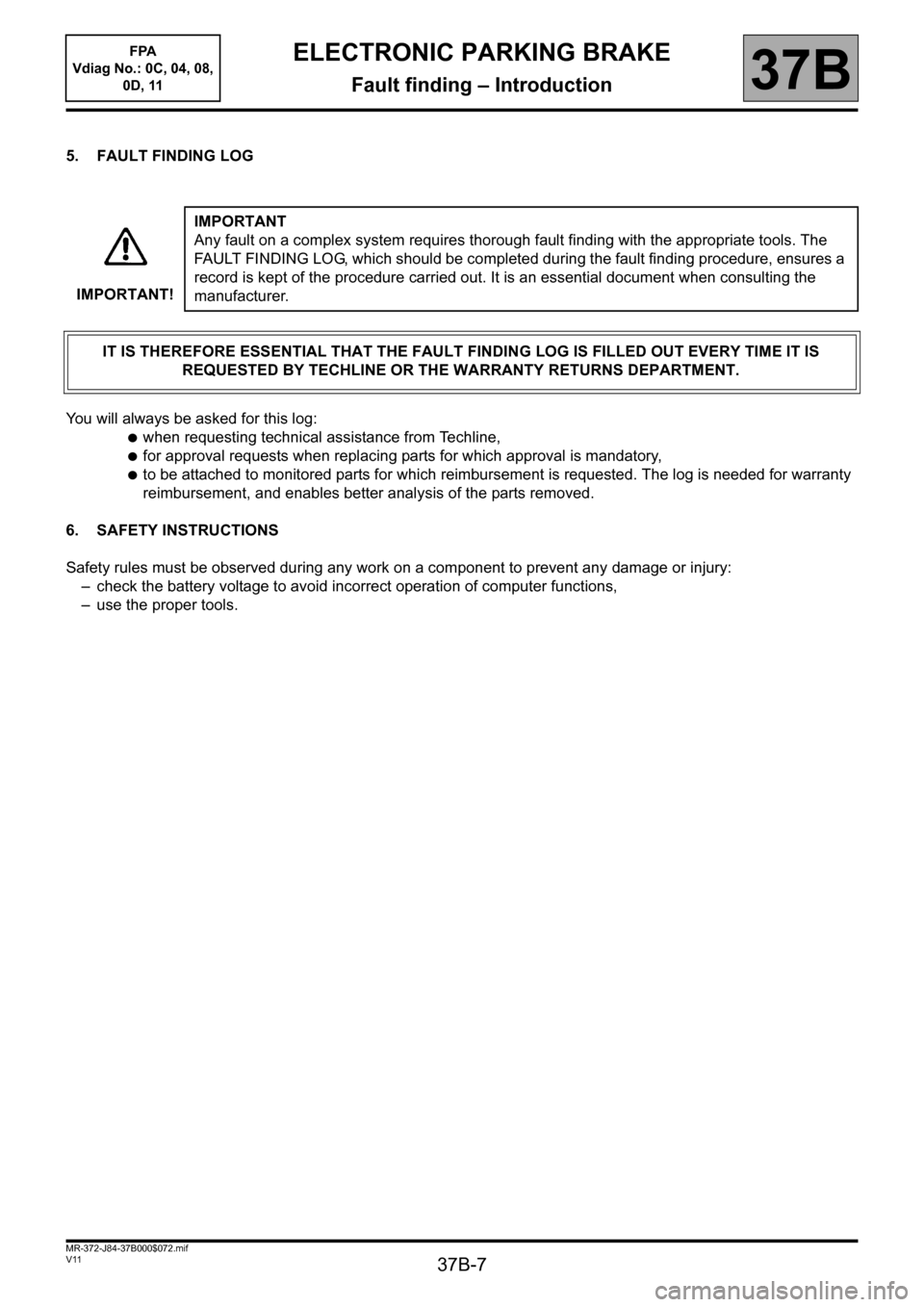
37B-7
MR-372-J84-37B000$072.mif
V11
ELECTRONIC PARKING BRAKE
Fault finding – Introduction
FPA
Vdiag No.: 0C, 04, 08,
0D, 11
37B
5. FAULT FINDING LOG
You will always be asked for this log:
●when requesting technical assistance from Techline,
●for approval requests when replacing parts for which approval is mandatory,
●to be attached to monitored parts for which reimbursement is requested. The log is needed for warranty
reimbursement, and enables better analysis of the parts removed.
6. SAFETY INSTRUCTIONS
Safety rules must be observed during any work on a component to prevent any damage or injury:
– check the battery voltage to avoid incorrect operation of computer functions,
– use the proper tools. IMPORTANT!IMPORTANT
Any fault on a complex system requires thorough fault finding with the appropriate tools. The
FAULT FINDING LOG, which should be completed during the fault finding procedure, ensures a
record is kept of the procedure carried out. It is an essential document when consulting the
manufacturer.
IT IS THEREFORE ESSENTIAL THAT THE FAULT FINDING LOG IS FILLED OUT EVERY TIME IT IS
REQUESTED BY TECHLINE OR THE WARRANTY RETURNS DEPARTMENT.
Page 8 of 115
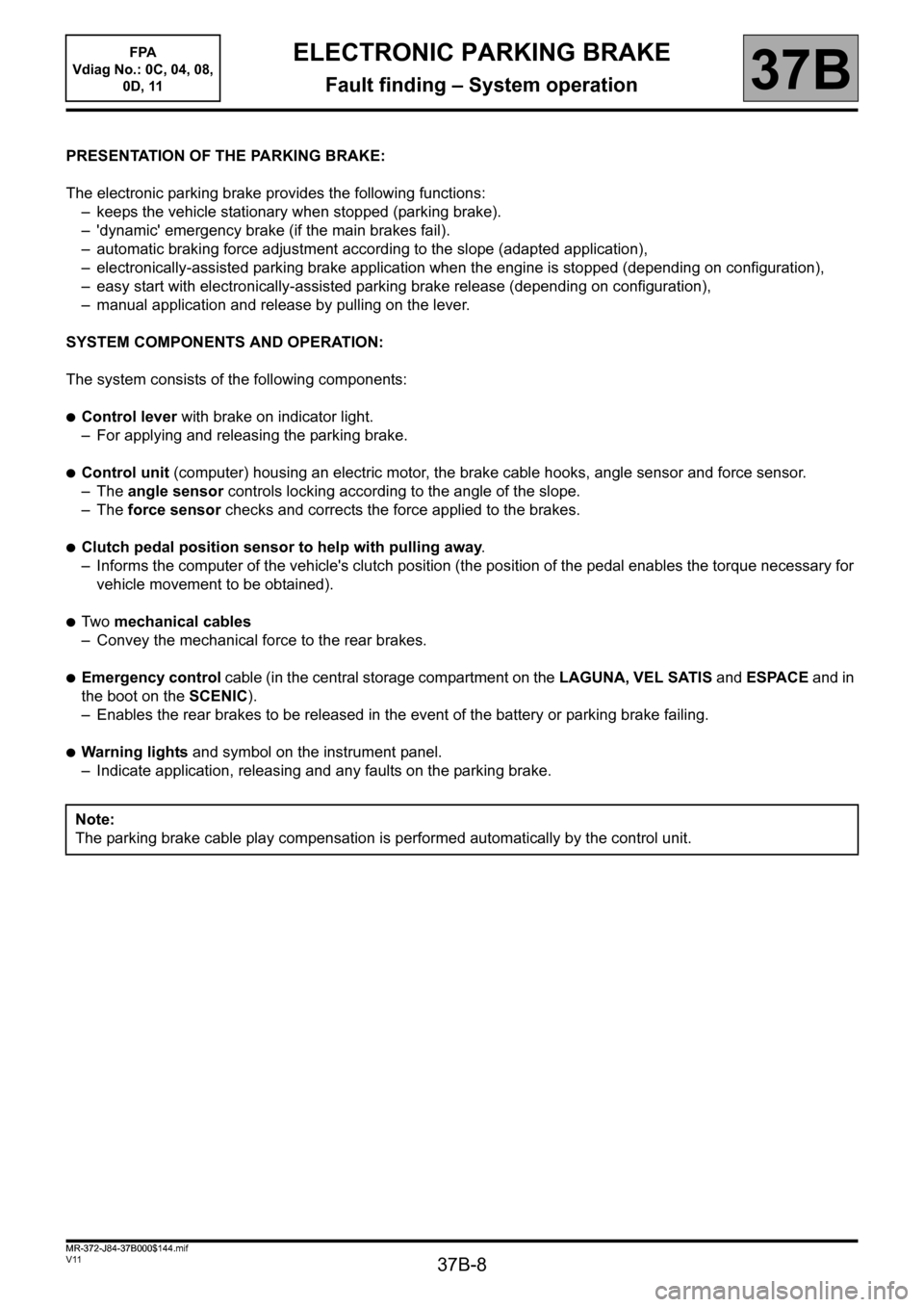
37B-8
MR-372-J84-37B000$144.mif
V11
37B
ELECTRONIC PARKING BRAKE
Fault finding – System operation
PRESENTATION OF THE PARKING BRAKE:
The electronic parking brake provides the following functions:
– keeps the vehicle stationary when stopped (parking brake).
– 'dynamic' emergency brake (if the main brakes fail).
– automatic braking force adjustment according to the slope (adapted application),
– electronically-assisted parking brake application when the engine is stopped (depending on configuration),
– easy start with electronically-assisted parking brake release (depending on configuration),
– manual application and release by pulling on the lever.
SYSTEM COMPONENTS AND OPERATION:
The system consists of the following components:
●Control lever with brake on indicator light.
– For applying and releasing the parking brake.
●Control unit (computer) housing an electric motor, the brake cable hooks, angle sensor and force sensor.
–The angle sensor controls locking according to the angle of the slope.
–The force sensor checks and corrects the force applied to the brakes.
●Clutch pedal position sensor to help with pulling away.
– Informs the computer of the vehicle's clutch position (the position of the pedal enables the torque necessary for
vehicle movement to be obtained).
●Tw o mechanical cables
– Convey the mechanical force to the rear brakes.
●Emergency control cable (in the central storage compartment on the LAGUNA, VEL SATIS and ESPACE and in
the boot on the SCENIC).
– Enables the rear brakes to be released in the event of the battery or parking brake failing.
●Warning lights and symbol on the instrument panel.
– Indicate application, releasing and any faults on the parking brake.
Note:
The parking brake cable play compensation is performed automatically by the control unit.
FPA
Vdiag No.: 0C, 04, 08,
0D, 11
MR-372-J84-37B000$144.mif
Page 9 of 115
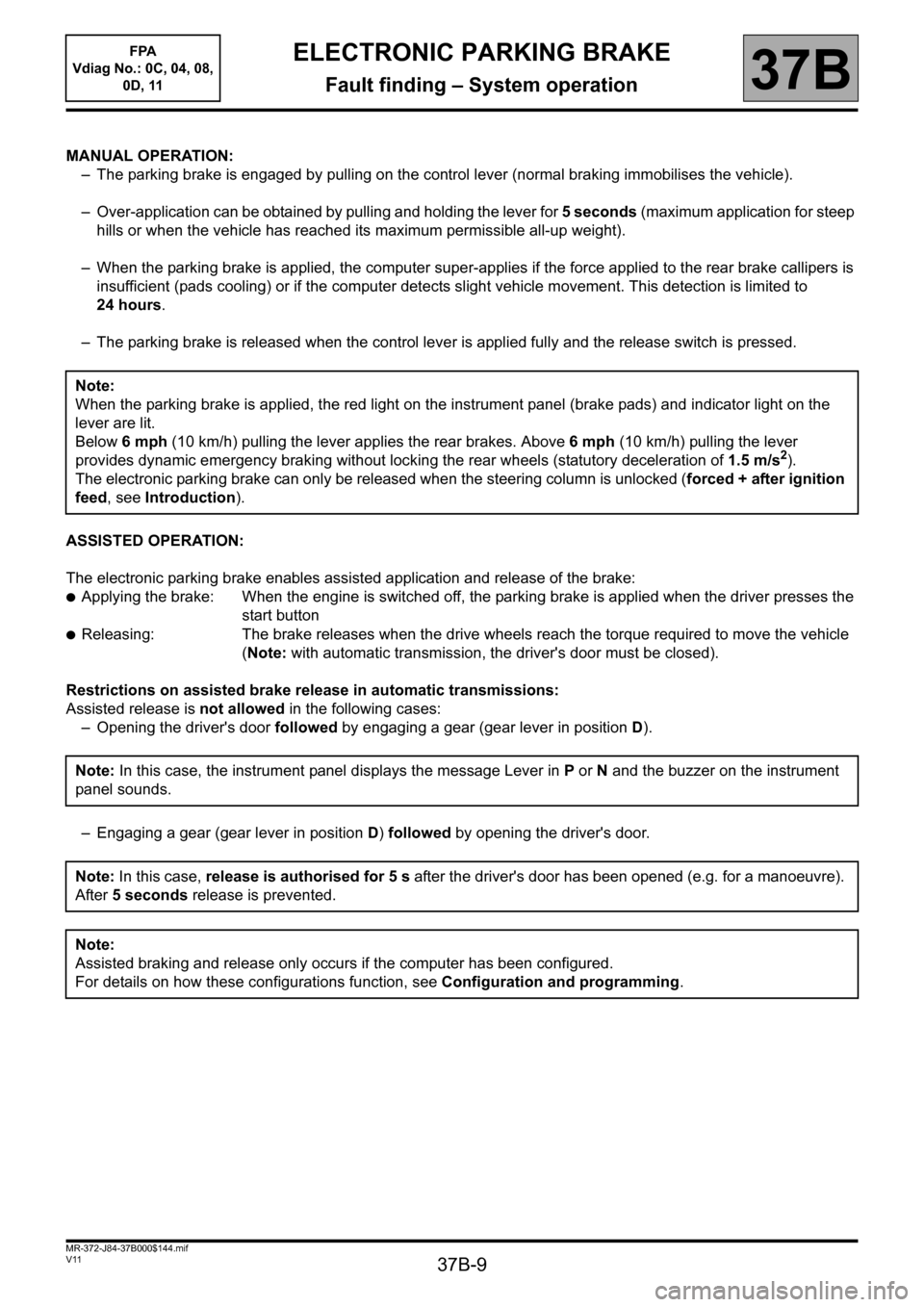
37B-9
MR-372-J84-37B000$144.mif
V11
ELECTRONIC PARKING BRAKE
Fault finding – System operation
FPA
Vdiag No.: 0C, 04, 08,
0D, 11
37B
MANUAL OPERATION:
– The parking brake is engaged by pulling on the control lever (normal braking immobilises the vehicle).
– Over-application can be obtained by pulling and holding the lever for 5 seconds (maximum application for steep
hills or when the vehicle has reached its maximum permissible all-up weight).
– When the parking brake is applied, the computer super-applies if the force applied to the rear brake callipers is
insufficient (pads cooling) or if the computer detects slight vehicle movement. This detection is limited to
24 hours.
– The parking brake is released when the control lever is applied fully and the release switch is pressed.
ASSISTED OPERATION:
The electronic parking brake enables assisted application and release of the brake:
●Applying the brake: When the engine is switched off, the parking brake is applied when the driver presses the
start button
●Releasing: The brake releases when the drive wheels reach the torque required to move the vehicle
(Note:with automatic transmission, the driver's door must be closed).
Restrictions on assisted brake release in automatic transmissions:
Assisted release is not allowed in the following cases:
– Opening the driver's door followed by engaging a gear (gear lever in position D).
– Engaging a gear (gear lever in position D) followed by opening the driver's door. Note:
When the parking brake is applied, the red light on the instrument panel (brake pads) and indicator light on the
lever are lit.
Below 6 mph (10 km/h) pulling the lever applies the rear brakes. Above 6 mph (10 km/h) pulling the lever
provides dynamic emergency braking without locking the rear wheels (statutory deceleration of 1.5 m/s
2).
The electronic parking brake can only be released when the steering column is unlocked (forced + after ignition
feed, see Introduction).
Note: In this case, the instrument panel displays the message Lever in P or N and the buzzer on the instrument
panel sounds.
Note: In this case, release is authorised for 5 s after the driver's door has been opened (e.g. for a manoeuvre).
After 5 seconds release is prevented.
Note:
Assisted braking and release only occurs if the computer has been configured.
For details on how these configurations function, see Configuration and programming.
Page 10 of 115
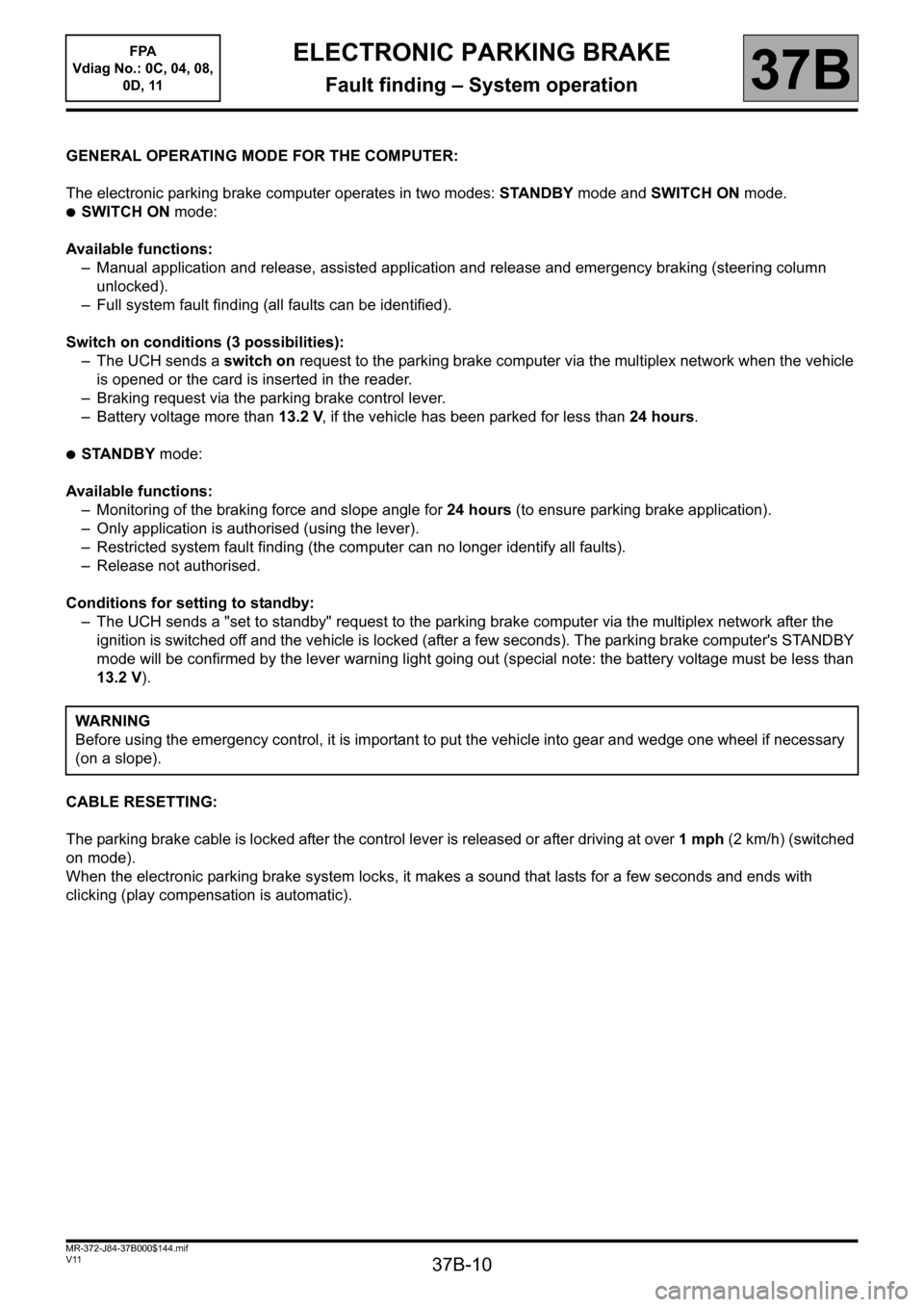
37B-10
MR-372-J84-37B000$144.mif
V11
ELECTRONIC PARKING BRAKE
Fault finding – System operation
FPA
Vdiag No.: 0C, 04, 08,
0D, 11
37B
GENERAL OPERATING MODE FOR THE COMPUTER:
The electronic parking brake computer operates in two modes: STANDBY mode and SWITCH ON mode.
●SWITCH ON mode:
Available functions:
– Manual application and release, assisted application and release and emergency braking (steering column
unlocked).
– Full system fault finding (all faults can be identified).
Switch on conditions (3 possibilities):
– The UCH sends a switch on request to the parking brake computer via the multiplex network when the vehicle
is opened or the card is inserted in the reader.
– Braking request via the parking brake control lever.
– Battery voltage more than 13.2 V, if the vehicle has been parked for less than 24 hours.
●STANDBY mode:
Available functions:
– Monitoring of the braking force and slope angle for 24 hours (to ensure parking brake application).
– Only application is authorised (using the lever).
– Restricted system fault finding (the computer can no longer identify all faults).
– Release not authorised.
Conditions for setting to standby:
– The UCH sends a "set to standby" request to the parking brake computer via the multiplex network after the
ignition is switched off and the vehicle is locked (after a few seconds). The parking brake computer's STANDBY
mode will be confirmed by the lever warning light going out (special note: the battery voltage must be less than
13.2 V).
CABLE RESETTING:
The parking brake cable is locked after the control lever is released or after driving at over 1 mph (2 km/h) (switched
on mode).
When the electronic parking brake system locks, it makes a sound that lasts for a few seconds and ends with
clicking (play compensation is automatic).WARNING
Before using the emergency control, it is important to put the vehicle into gear and wedge one wheel if necessary
(on a slope).